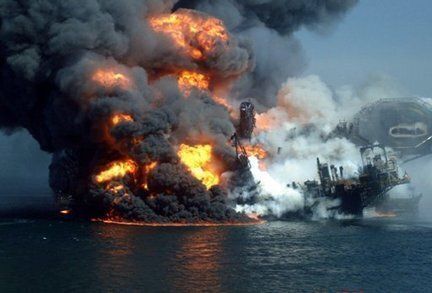
After an estimated 4 million barrels of oil oozed out into the ocean due to an oil rig explosion, BP's leaking "Deepwater Horizon" site was finally stemmed after 87 days of pollution in 2010. We were led to believe that the corrosive aftermath would be cleared and the environment restored to its natural state with the help of advanced booming techniques and corexit dispersal - a chemical which some scientists claim actually adds to the toxicity of the water.
Months after the catastrophe was ended however, the once clean beaches of the gulf were still saturated in crude oil which had allegedly been hidden under futile layers of sand at the hands of hired help, whilst birds, fish and other animals were quite literally choked to death on surplus oil. Not to mention the hundreds of fishing businesses that were hung out to dry due to BP's suspected negligence toward the dilapidated rig, which left 11 workers dead in its wake. The Deepwater disaster was a harrowing blow to BP's already dubious reputation, and critics argue that their attempts at rehabilitating the area were hollow and relatively ineffective.
All this though, is now an ill-fated memory being pushed to the back of the BP history books, as they once again revel in gigantic profit margins. But with ad campaigns urging tourists to test the waters of the gulf and see what a wonderful job of replenishing the area they've done, BP could actually be up to their necks in deep oily water once more.
A non-profit organisation called "On Wings of Care" that preserves and protects wildlife, has recently speculated that a new oil leak has burst through the seemingly secure well that was capped only a year ago. They have new footage showing a ten mile long streak of oil rising to the surface of the sea. BP has profusely denied a new leak, saying that "none of this is true". They could soon be eating their words though, as scientists have confirmed that the oil samples taken from the new slick, matches that of the old Deepwater disaster oil - which means it's either a new leak from the Macondo well, or natural seepage from the ocean bed.
Although the petroleum giant denies the threat of a new disaster, there has purportedly been up to 40 BP hired ships spotted laying boom at the site. Boom is a plastic tarpaulin that floats on the surface of the water with a weighted skirt submerged below. The boom is used to collect stray oil and stop it drifting out further to sea. If done correctly, booming can be effective for oil spills, however BP's efforts have been hugely criticised by scientists and booming experts, who claim that the techniques used last year were doing nothing to stop the swarthy pollutant spreading further. The question that lingers though, is why would BP be hiring 40 ships to venture out into Macondo waters with boom, if there was no truth to the leakage allegations in the first place?
The situation is of course rife with speculation as wounds are still tender. It could well be that these reports are incorrect, simply a ploy to viciously discredit BP as revenge for the damage their oil caused, or even trigger happy overreactions to any bit of grime that bubbles up in the delicate waters of the Gulf. However, if all these images of new oil swimming in the gulf are in fact legitimate evidence of a fresh leak, BP could find itself up an oily creak without a paddle, as a new leak could mean a rupture in the sea bed itself. This would effectively make the Deepwater Horizion disaster the worst case of accidental oil spillage in the history of mankind, a tagline BP would be unlikely to incorporate in its next apologetic ad campaign.